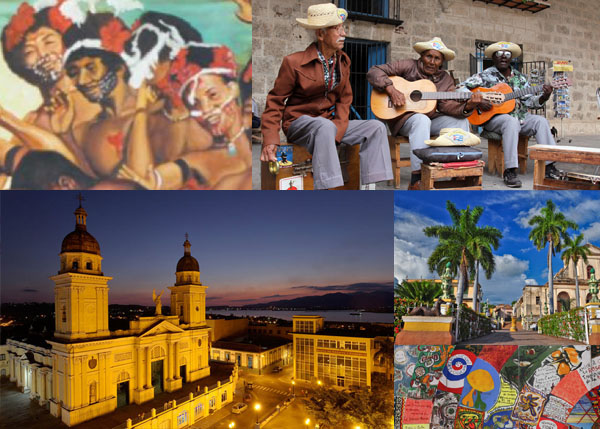9.2.1 The Rumba.

In Cuba, at the end of the 19th century and the beginning of the 20th century, a fusion of black music with Spanish music took place. This marked the emergence of two varieties among the black population. In the east (Santiago de Cuba, Bayamo, Guantánamo, etc.), the Son Complex developed. In western Cuba (Matanzas, Havana), the Rumba Complex developed. Both Son and Rumba are very different genres.
The Cuban Rumba, composed of drum beats, songs, dances, and mime, is one of our most prestigious folk and popular musical expressions, and has spread to other nations. Its principal performers were free Black people and their descendants, belonging to various African ethnic groups such as the Lucumí, Ganga, Arará, and perhaps the most significant of all, the Gangá-Bantú. The Rumba has a secular and festive character. It is a Cuban instrumental vocal genre, with a responsorial style (alternating solo and chorus). The soloist generally begins with a kind of lalaleo to tune the chorus.
There are three main variants of the Rumba complex:
The Yambú.
Colombia
The Guaguancó
The instrumentation for the Rumba includes three tumbadoras. Two of the drums (the first tumbadora and the second or third) mark the basic rhythm; the third tumbadora, called the “quinto” (which is tuned higher), plays the improvised beats, the flourishes directed at the dancers.
Yambú is the slower-tempo variant, with less figurative rhythm. The dance imitates the movements of elderly people.
The fast-paced Columbia is the most rhythmically figurative. The dance is a skillful one, dominated by men. Its most important characteristic is that it establishes a challenge or competition between the fifth player and the male dancer.
Of the three Rumba variants, the Guaguancó is the most elaborate, both musically and lyrically. The Guaguancó has a slightly slower tempo than the Columbia and faster than the Yambú. Its rhythm is figurative. It is a couples’ dance, and features the so-called vacunao or abrochao (a pelvic movement of his waist toward her genitals, which she always takes care to avoid).
Guaguancó is a distinctive dance from the Black neighborhoods of Havana. The other two variants (Yambú and Columbia) are rural and from the province of Matanzas. Its singing is entirely in Spanish, rather than using African expressions or slang vocabulary from the slums. The song is extensive. Lyrically, Guaguancó is closely related to Punto Cubano and presents a marked narrative intent, as well as diverse themes. At the beginning of the 20th century, groups of men and women specialized in playing guaguancó, known as choirs, existed. They had their own premises where they met to rehearse and perfect the lyrics and vocals of their songs.








